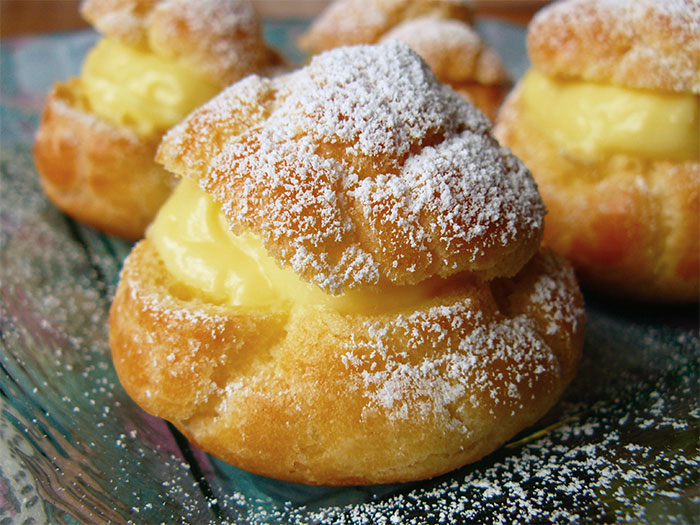
Chou à la Crème
| Ingredient | 15 2" Choux | 15 5-6cm Choux |
|---|---|---|
| whole milk | ¼ cup | 60cc |
| water | ¼ cup | 65cc |
| sugar | ½ tsp. | ½ tsp. |
| salt | pinch | pinch |
| butter | 4 Tbsp. | 60g |
| cake flour | heaping ½ cup | 75g |
| egg | 3 | 3 |
| crème pâtissière | about 1½ lbs. | about 700g |
| powdered sugar | to dust | to dust |
This recipe comes from Japan where these French-style cream puffs are the standard. Called shuu cream there, they take their name from the French chou (the puff pastry) and the English cream. The resulting chou à la crème (plural choux à la crème) contrast a light pastry shell with a thick, rich crème pâtissière custard filling for an experience somewhat different from the usually lighter American cream puff, but every bit as heavenly when it comes to taste.
Preparation

- Prepare one batch of crème pâtissière.
- Sift the flour two or three times.
- Slice the butter into 1cm (half-inch) pats.
- Let the eggs come to room temperature, crack them into a bowl, and scramble well.
- Lay a piece of parchment paper on a cookie sheet.
- Preheat oven to 200°C (400°F).
Directions
Pâte à choux
- Mix all ingredients other than flour and egg and heat.
In a large pan mix the milk, water, sugar, salt and butter. Heat over medium until the butter melts. - Add flour and mix quickly.
When the butter is completely melted and the mixture begins to boil, add the flour all at once, remove from heat, and stir rapidly with a wooden spoon until smooth. - Return to heat.
Put the pan back on the stove and heat on medium, stirring, until a thin film forms on the bottom of the pan. Remove from heat and turn off stove. - Mix in two thirds of eggs.
Add one third of the eggs to the hot batter, a little at a time, stirring briskly with a wooden spoon. Continue stirring until the batter is smooth, then add half the remaining egg and stir briskly until completely mixed. - Add remaining egg, observing consistency.
Begin adding the remaining egg a little at a time, stirring until completely mixed and checking the thickness each time. When the batter falls in a thin triangle from the spoon it is ready; save the leftover egg. - Pipe batter onto pan.
Put the batter into a pastry bag with a 1cm (third-inch) circular tip. Holding the bag straight up, squeeze out 3cm (1") disks of batter, 3-4cm (2") apart. Don’t move the bag while squeezing; twist slightly and pull up to finish, leaving a small point on top of a round mound of batter. - Paint tops with remaining egg.
Using the leftover egg, gently push down the points on top of the mounds with a brush and dab a little egg on top. If your oven and pans aren’t big enough to bake the entire batch at once, lay the bag on top of the oven or somewhere else to keep it warm while the first batch bakes; if it cools too much, the puffs won’t rise. - Bake.
Bake at 200°C (400°F) for 10-15 minutes; when the puffs have fully risen and browned slightly reduce the temperature to 180°C (350°F) and bake for another 10 minutes, or until light golden. Cool on a cake rack when finished and bake the remaining batter.
Assembly
- Cut each puff one third of the way down from the top with a sharp knife; they should already be mostly hollowed out. Fill the inside of each puff as full as you like with crème pâtissière using a pastry bag or spoon and stick the top back on. Dust with powdered sugar to decorate.
Notes
- If the temperature in the oven drops while the puffs are still rising they could collapse, so it’s better not to open the oven, particularly if you have a small oven.
- Although the English measurement conversions given here can be used in a pinch, as with most confections the more precise the better, so it’s a better idea to use a cooking scale and the metric amounts given.
